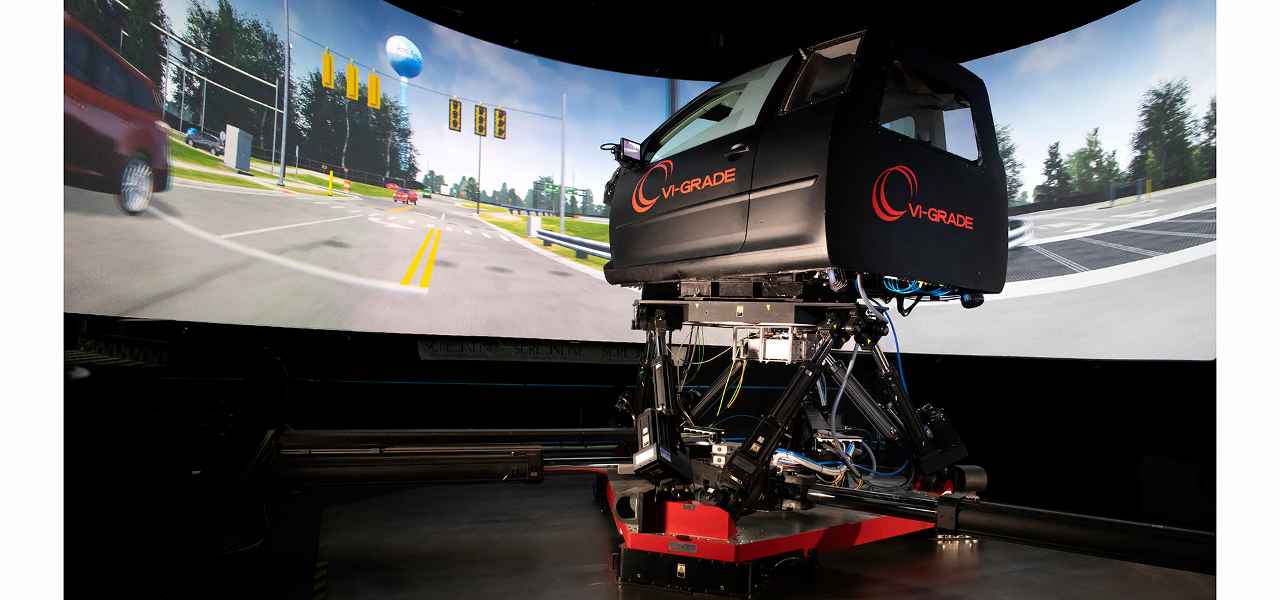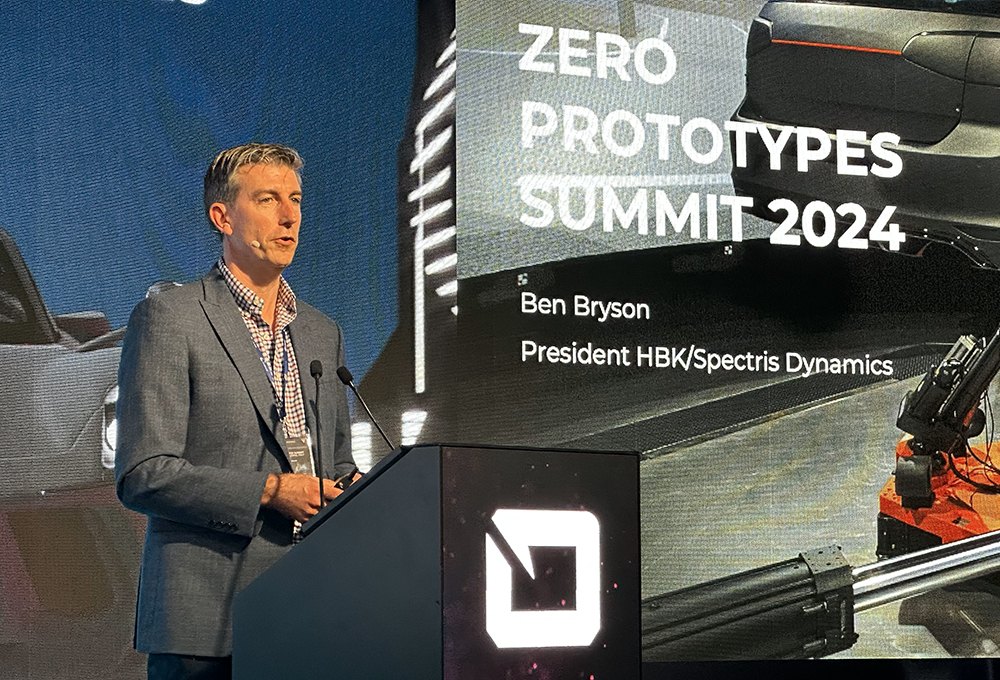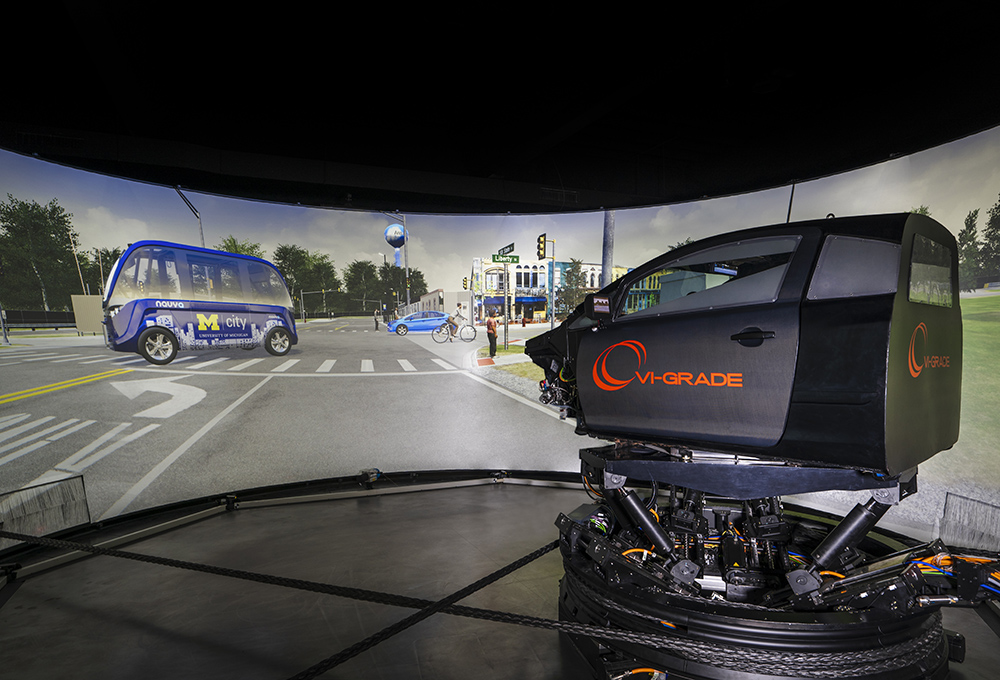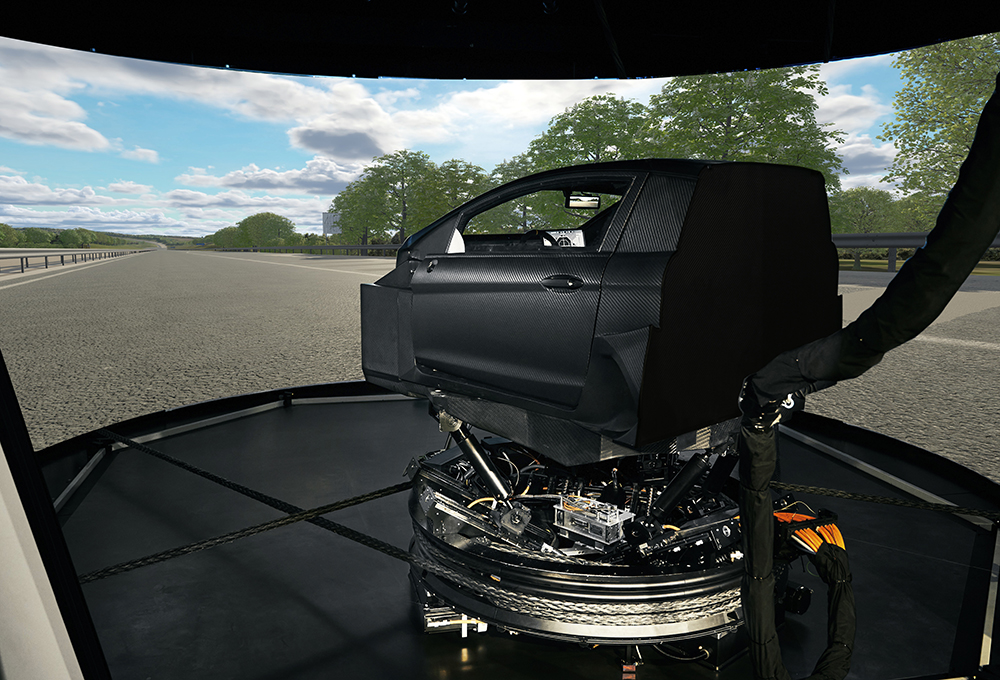 VI-grade的驾驶员体感DiM50模拟器可与其VI-WorldSim驾驶场景仿真软件结合使用。(VI-grade)
VI-grade的驾驶员体感DiM50模拟器可与其VI-WorldSim驾驶场景仿真软件结合使用。(VI-grade) HBK总裁Ben Bryson在ZPS 2024 发言。(SEBASTIAN BLANCO)
HBK总裁Ben Bryson在ZPS 2024 发言。(SEBASTIAN BLANCO) VI-grade 的 Driver-in-Motion DiM50 是一种动态驾驶员在环模拟器,可进行驾驶和操控以及 ADAS 模拟。(VI-grade)
VI-grade 的 Driver-in-Motion DiM50 是一种动态驾驶员在环模拟器,可进行驾驶和操控以及 ADAS 模拟。(VI-grade) 密歇根大学将在其 Mcity 高级交通研究中心使用 VI-grade 的动态驾驶 DiM400 模拟器。(VI-grade)
密歇根大学将在其 Mcity 高级交通研究中心使用 VI-grade 的动态驾驶 DiM400 模拟器。(VI-grade) EDAG车辆运动与高性能车辆高级专家Jonas Grötzinger在 ZPS 2024 上发表演讲。(SEBASTIAN BLANCO)
EDAG车辆运动与高性能车辆高级专家Jonas Grötzinger在 ZPS 2024 上发表演讲。(SEBASTIAN BLANCO) 与最初的 DiM150 和 DiM250 模拟器相比,DiM400 在下级平台上使用了独特的电缆驱动系统,使运动包络面更大,曝光时间更长。(VI-grade)
与最初的 DiM150 和 DiM250 模拟器相比,DiM400 在下级平台上使用了独特的电缆驱动系统,使运动包络面更大,曝光时间更长。(VI-grade) 米兰理工大学为 2023 年的 1000 Miglia 自动驾驶大赛改装了一辆采用自动驾驶技术的玛莎拉蒂 MC20 Cielo。(SEBASTIAN BLANCO)
米兰理工大学为 2023 年的 1000 Miglia 自动驾驶大赛改装了一辆采用自动驾驶技术的玛莎拉蒂 MC20 Cielo。(SEBASTIAN BLANCO) VI-grade董事总经理 Guido Bairati。(SEBASTIAN BLANCO)
VI-grade董事总经理 Guido Bairati。(SEBASTIAN BLANCO)
VI-grade推出了一款可用于多属性虚拟测试的驾驶员体感全频谱动态模拟器(DiM FSS)。
尽管5月中旬的意大利东北部阴雨绵绵,但2024年VI-grade零原型峰会(ZPS)的现场气氛却十分明朗。VI-grade的全球合作伙伴纷纷亲临现场,见证VI-grade新款多属性应用DiM FSS的全球首次亮相。
DiM FSS是VI-grade先进驾驶员体感模拟器的升级版,采用碳纤维驾驶舱,并配备可安装在现有动态驾驶器顶部的振动器,能够同时提供NVH和动态模拟。
对于总部位于德国达姆施塔特的VI-grade而言,5月是一个忙碌的月份。该公司于2018年被Spectris plc收购,现在隶属于HBK的虚拟测试部门(HBK本身隶属于Spectris plc)。HBK总裁Ben Bryson在接受SAE采访时表示,VI-grade虚拟测试工具可以显著缩短产品上市时间,“在某些情况下,甚至可以缩短一半,”同时它还可以削减高达20%的成本。他还指出,除了上述优势外,VI-grade虚拟测试工具还可以获得实时、准确的反馈,高端品牌对此尤其感兴趣。
宾利在ZPS峰会上发表了一场题为“虚拟优先(Virtual-First)思维在工程设计中的重要性”的演讲。该公司5月上旬就已宣布,将使用VI-grade紧凑型FSS模拟器为其即将推出的电动汽车构建虚拟原型,并强调将重点用于改进NVH开发以及驾乘与操控调试。宾利将在其位于英国克鲁的新建驾驶员在环(DiL)中心安装紧凑型FSS。
美国密歇根大学先进出行研究中心Mcity也于5月宣布,将使用VI-grade紧凑型模拟器和VI-grade VI-WorldSim软件堆栈测试自动驾驶技术。
本次峰会上最重磅的消息或许是,独立工程服务供应商EDAG集团宣布将于今年春季开放其位于德国沃尔夫斯堡的第一家配备VI-grade线缆驱动DiM500模拟器的零原型实验室(ZPL)。EDAG车辆运动与高性能车辆高级专家Jonas Grötzinger向SAE媒体透露,该实验室还拥有另外两个VI-grade模拟器——1个桌面级模拟器和1个紧凑型FSS模拟器,两者均可运行Autohawk16。但DiM500模拟器更有可能使OEM(例如位于实验室附近的大众汽车)选择使用EDAG的服务。DiM500模拟器的纵横向移动量为5米(16英尺)、1.5G力,垂直移动量为298mm(12英寸)、2.5G力。
“我们还可以将这些功能进行组合。比如,只播放前轴或后轴的声音,或同时播放,此外还可以增加或去除风噪等等。这些功能对于工程师非常有用,因为在现实世界或试验场上很难实现这些操作。”他笑着说,“毕竟拆除了一根车轴,汽车就没办法驾驶了。”
Grötzinger表示,“DiM500只能运行特定频率的结构输入,但FSS模拟器对结构传递路径和空气传递路径没有限制,因此空气噪声模拟只能在FSS模拟器上进行。我们可以使用在汽车试验场测量的空气噪声和模拟器的信号,还可以使用模拟的传递路径。”
VI-grade董事总经理Guido Bairati向SAE表示,一家公司使用的模拟器数量越多,其虚拟测试的整体效果就越好。
他指出,“我坚信2024年可全面实现虚拟汽车开发的目标,这意味着贵公司在生产第一辆实体原型车时就已基本正确无误。然而,有些公司的决策制定者依然持有老派工程师的观点,他们不太相信仿真模型的可靠性和可预测性可以达到真实汽车的水平,文化观念的转变还有待实现。”
Despite rainy skies above northeastern Italy in mid-May, the mood at VI-grade’s 2024 Zero Prototype Summit (ZPS) was decidedly sunny. VI-grade’s partners from around the world were on hand to see the world premiere of the company’s new Driver in Motion Full-Spectrum Dynamic Simulator (DiM FSS) that allows for multi-attribute applications.
An update to VI-grade’s advanced DiM units, the DiM FSS features a carbon fiber cockpit with shakers that can be mounted on top of VI-grade’s existing dynamic simulators to provide NVH simulations at the same time as dynamic simulations.
May was a busy month for the Darmstadt, Germany-based VI-grade (owned since 2018 by Spectris plc). VI-grade is part of HBK’s Virtual Test Division (HBK is itself part of Spectris plc). HBK CEO Ben Bryson told SAE Media that VI-grade’s virtual test tools can significantly improve time to market - “in some cases, it’s halved,” he said - while reducing costs by up to 20%. These benefits, as well as getting real-time, accurate feedback, are of particular interest to premium brands, he said.
“Companies like BMW and AMG need to know that their brand is protected through the innovation cycle, and that the products that they’ve designed, their physical attributes, the structural load and dynamics, match how the driver feels in that environment,” he said.
Bentley Motors participated in ZPS with a presentation on the “Importance of a Virtual-First Mindset in Engineering.” The automaker backed up this viewpoint by announcing earlier in the month that it would use VI-grade's Compact FSS Simulator to build virtual prototypes of upcoming EV models, noting specifically that the digital tools would be used to improve NVH development and ride and handling tuning. Bentley will install the Compact FSS at its new Driver-in-the-Loop (DiL) Hub that it is building in Crewe, UK.
In the U.S., the University of Michigan's advanced mobility research center, Mcity, also announced in May that it would use VI-grade’s Compact Simulator to test autonomous technologies with VI-grade’s VI-WorldSim software stack.
EDAG’s Zero Prototype Lab opening soon
But perhaps the biggest news out of ZPS was independent engineering services provider EDAG Group announcing it would open the first EDAG Zero Prototype Lab (ZPL) in Wolfsburg, Germany, this spring featuring VI-grade’s Cable Driven DiM500 Simulator. Jonas Grötzinger, senior expert for vehicle motion and performance vehicles at EDAG, told SAE Media that the ZPL already has two other VI-grade simulators – a desktop unit running and a Compact FSS simulator both running Autohawk16 – but it’s the DiM500 that is more likely to convince OEMs, including nearby VW, to use EDAG’s services. The DiM500 has 5 meters (16 ft) and 1.5G of longitudinal and lateral movement and 298 mm (12 inches) and 2.5G of vertical movement.
“We choose the DiM500 because we can do one-to-one cueing for a lot of relevant maneuvers, including double lane change maneuvers, in combination with a good ride comfort performance,” he said. “On a smaller simulator. like a DiM250 or DiM400, you have to use lower cueing so it’s not one-to-one to the force you get on the body, it’s maybe 0.5 or 0.7. That means the driver had to adapt his feeling to the simulator.”
It’s the combination of simulators that Grötzinger said sets EDAG’s ZPL apart.
“We also have an FSS simulator in the lab because we want to combine the attribute development between the handling and steering with the attribute development in NVH and higher frequency ride comfort, and I think this combination is unique on the market,” he said. “The additional desktop simulator [can be used] to update models, to develop models, and do small checks of the models before using the other simulators.”
The combination of the DiM500 and the FSS simulator also means EDAG can run completely new tests by regenerating data from real-world tests or from simulations.
“You can also make a combination out of this. You can hear only the input from the front axle, or only the input from the rear axle, or from both. You can add wind noise or remove wind noise, and so on. It’s quite good for the engineers because it’s quite difficult to do it in the real world or on the proving grounds,” he said, laughing. “It’s not possible to remove one axle and then drive the car again.”
“With the DiM500, we can only run structural inputs up to a certain level of frequency,” he said. “With the FSS simulator, there’s no limit between the structural transfer path and airborne transfer path. Of course, the airborne noise will be simulated in the FSS simulator. And we can use airborne noise that was measured from a car on the proving ground and use the signals in a simulator as well as we can use transfer paths from the simulation.”
The more, the merrier
VI-grade managing director Guido Bairati told SAE Media that the more simulators a company uses, the better its overall virtual testing becomes.
“If you really want to change the way you develop vehicles, if you really want to accelerate product development, if you really want to decrease the number of physical prototypes, you have to believe in what simulation and simulators can do,” Bairati said. “Believing in a simulator means that you start using simulators in all different locations like Ford is doing, like Stellantis is doing, like Honda is doing, and you need to have a number of simulators in order to study all different disciplines virtually using digital twins. That’s the only way to be able to really say that you are changing the way you develop vehicles and that you are shrinking the development time.”
Despite the sunny predictions at ZPS, there were some clouds obscuring exactly when the industry will reach truly zero-prototype development capability. During breaks and informal conversations, many attendees told SAE Media they face steep challenges getting their companies to fully invest in virtual testing, despite the potential benefits. Bairati, though, said he thinks companies are closer to zero prototypes than they’re willing to say.
“I’m fully convinced that in 2024, a vehicle can be developed fully, virtually,” he said. “That means the first prototype you build, it’s basically right. But some of the decision-makers are still old-school engineers, and they don’t really believe that simulation models can reach the level of reliability and predictability that they actually are able to reach. It’s a cultural shift.”
等级
打分
- 2分
- 4分
- 6分
- 8分
- 10分
平均分
